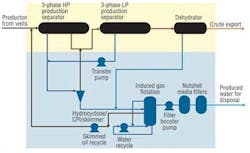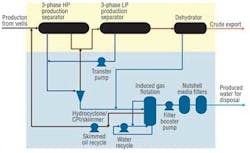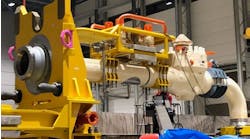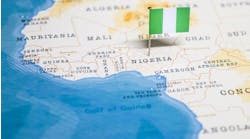Timothy P. Daigle
Savanna N. Hantz
Brian Phillips
Rafique Janjua
Fluor Offshore Solutions
Technology is evolving to automate water separation and purification in deepwater for environmentally safe discharge at the seabed when pressures in reservoir pockets depletes and water cuts increase.
Major challenges to this discharge are remote process train control and monitoring, and the ability to perform routine maintenance while wells flow.
Seabed discharge of produced water and/or solids has many benefits. The three main ones are to:
- 1. Eliminate the need to transport huge volumes of water from deepwater production sites to the tieback hosts, reducing the production system costs
- 2. Decrease the hydrostatic pressure on the subsea production flowlines to help reduce back pressure on the subsea wellhead and ultimately allow for more production
- 3. Minimize the topside equipment footprint and protect the equipment from damage by weather.
On a typical offshore facility, the produced water from the primary oil/water separator has to be treated before discharge. Separated water from all sources (HP/MP/LP separators, wash water from desalter/dehydrator, crude stabilizer overhead separator, condensate collection drum, condensate-stripper-overhead drum, gas dehydration units) are collected and sent to a produced water treatment package (PWTP) for recovery of oil and treatment of water. From the PWTP, the treated water is injected into subsea disposal wells or discharged to sea. The separating efficiency depends largely on the quality of the water being treated, i.e. on the concentration of oil and the average size of the oily particles.
A review of state-of-the-art in topsides and subsea technologies relevant to seabed produced water treatment and discharge shows the following:
- Available offshore water treatment technologies are primarily used topsides. There are a few subsea projects which separate oil and water. There is no subsea water treatment for discharge.
- Subsea separation technologies focus on two-phase gas/liquid separation. Installations with oil/water separation intend to inject water into wells, which allow much higher oil-in-water content than discharge limitations. Suspended solids in the water are major challenges for injection.
- Compact subsea oil/water separators and desanders for deepwater have been developed and are to be installed in the near future. Multiple technologies in this area are under development.
- Currently subsea oil/water separation systems do not meet discharge limitations on oil and grease concentrations. They can achieve oil-in-water concentrations of several hundred ppm, or about 10 times the discharge limit.
- Control and monitoring of the process is critical to make regulatory agencies confident that such processes are working and effective.
Ultra-deepwater seabed treatment and discharge of produced water and/or solids likely requires significant power for control and monitoring, and for pumping the large volume of water necessary to overcome the differential between the seabed hydrostatic pressure and the treatment system pressure. Current technology can provide the power required.
A strong design basis is critical to selecting the key components for a subsea produced water treatment system. Many configurations can be designed and deployed, but it is important to achieve some standardization in what works best subsea. It is critical to include vendor experience and opinion where appropriate.
For basic concepts that can be standardized, sands and solids handling must be addressed at the front end of the process train to avoid plugging. In addition, some components work better at low pressure while others require higher pressure to enable coalescence and separation. All the systems will be subjected to external hydrostatic head pressure of 2,500 psi to 4,000 psi (17.24 to 27.58 MPa) in water depths of 5,000 to 8,000 ft. (1,524 to 2.438 m). At these depths the ambient temperature may be only 38°F (3ºC) and many of the processes work better warm. This suggests a compact thermally insulated system.
Component size and weight must be considered. Large, thick-walled pressure vessels may have to be installed individually without guidelines. Compact seabed templates increase the hazards of dropped objects. Safety zones around the process train can be staged. The pumps, switch gear, transformers, chemicals, and controls equipment make for a large installation area on the seabed. The design will be a remote installation with intervention and maintenance kept to a minimum for both safety and cost reasons.
The fewer stages in the train, the simpler the installation and controls. No moving parts and corrosion resistant materials minimize maintenance. External pumps and manifolds could be modularized for recovery to the surface for repair or maintenance.
Forward planning at the installation design stage can introduce modules tailored to the needs of the production fluid. Flow can be shunted through the separator module and back to the flowline. The same could happen with the pump and compressor module, or the flow could be routed from the separator through the water treatment train and straight into the pump module.
The use of the next generation of compact flotation technology (CFT) is new to the North America, but is well proven worldwide, with more than 50 installations on offshore platforms. The Cameron TST CFU is the next generation compact flotation unit and uses gas flotation and additional centrifugal forces to separate and remove hydrocarbons as liquid and gas, aromatic compounds, hydrophobic substances, and small solid particles from produced water. The technology uses special internal to mix gas and oil through several stages within one vessel. These internals are designed for effective separation of this gas and oil from the water. The TST CFU performed well under high OIW concentrations and small oil droplet size distributions. This can handle higher inlet oil concentrations, over 1,000 ppm, and provide lower outlet OIW concentrations <10 ppm. The TST CFU system requires less equipment, has a lower weight, smaller footprint, is less dependent on chemicals, and may replace multiple produced water treatment stages.
Research shows that using vessels with a diameter no more than 3 ft. for collapse resistance is reasonable, and would be more cost effective and easier to manufacture.
Many new subsea processing designs are being identified and tested every day. One such technology is the Unocell design from Fluor. Unocell chemically treats an underflow from a primary water knockout drum where it enters the Unocell vessel tangentially into the center column. Then the mass flow spins and rises at a controlled optimum velocity through the center column, enhancing the coalescence of oil particles. The flow exits upward into the established pool of oil and water and is forced to turn uniformly downward in the opposite direction
The downward flow velocity is lower than the rising velocity in the center column, and the free oil in the incoming water is trapped in the oil pool at the oil/water interface. Large oil droplets and the difference between the specific gravities of oil and water helps float away entrapped oil in the downward traveling water before it exits the Uno-Cell. Recovered oil accumulates at the top of the vessel and its level begins to rise. At the predetermined set point, the effluent valve starts to close slowly.
As the water level in the Uno-Cell rises, it pushes the accumulated oil through the v-notch weir into the effluent launder and out the exits line. At a predetermined level, as the recovered oil is being removed, the effluent valve starts to open to lower the water level to the normal operating level. This repeats continuously.
Any settable suspended solids accumulate at the bottom of Uno-Cell and are flushed out the valve at the bottom of the vessel into a solids accumulator for disposal. The recirculation pump outside the vessel ensures the optimum chemical process by constantly introducing treated water to the incoming untreated produced water. This maintains a constant flow rate through the center column for consistent oil removal.
Units like these can run in parallel to handle as much volume and redundancy as needed.
Technology gaps
The following potential gaps have been identified. Some gaps exist because no technology has been developed or adapted to this application.
Sand and solids removal. As the water content increases, the producing structure breaks down, sand flows with the fluid, and can plug the screens. So, it must travel to the top of the well for extraction and to allow the well to flow.
Sand causes erosion and blockage. Trees and valves can be designed for sand service, but GoM experience shows that sand and oil form a mass that quickly solidifies if not kept moving. Sand and the other solids need to be removed as close to the wellhead as possible to limit damage and to use the higher pressure to make the desanding cyclones more efficient.
Sand has to be transported to the surface or pumped into an unused well for disposal. If the field has only one flowline, as oil production declines and water is removed, the flow rate drops. If sand is reintroduced to the flowline after the water separation, it may not entrain the sand all the way to the surface. Regular pigging could be required. If other, more productive wells are introduced or the field has two flowlines for round-trip pigging but only one is used for the "new" flow, then the flow rate might carry the sand.
Filter design. Many filters give the required water purity in surface installations. The difficulty is transferring that technology to the remote seabed. The performance of a filter in terms of surface area to volume flowing and how compactly that surface can be enclosed in a collapse resistant pressure vessel is a major selection criterion.
Control system. Subsea high integrity pressure protection system (HIPPS) has not gained acceptance in the GoM although the technology is in service elsewhere. The relevance is the control requirements for autonomous, remote, paired functions subsea. For HIPPS this is two fast-closing, large-bore gate valves. Flow is monitored by pressure sensing and valve action is triggered by a logic voting control system. The process train will have the equivalent control points between stages giving feedback on flow rates, fluid impurities, temperature, and pressure. A long and favorable track record on the surface is required before this technology can be transferred subsea. Until then, this is a technology gap.
Power supply. Ultra-deepwater electrical power booster pump technology development is under way. The need for local variable speed drives (VSD) may not have reached the seabed yet. If the process train needs several electrical motors working independently, power distribution to each motor's VSD and the appropriate control is required. With the work, experience, and hardware available, this is not a technology gap.
Valves. Flow from the drill center will probably be through a single line. This probably requires flowlines with gate valves that respond quickly to commands. Neither fast-opening nor dual-action is a common specification, but the technology exists. Electrically powered actuators could be considered. Flow modulating valves of a significant size to adjust the flow rates through the train are a bigger challenge. Choke technology may help, but the mechanical mixing could cause emulsion problems. This needs investigation.
Marinization and pressure vessels. Given the ambient seabed pressure, a simple analysis of the collapse load on a cylindrical vessel shows that a 3-ft diameter vessel would need a 1½-to 2-in. (3.8 to 5 cm) wall thickness. Boiler makers do fabricate vessels in much larger diameters and wall thickness. The issue is cost, not availability.
Seabed discharge legislation. Protection of the environment is the priority. Discharge of processed water at the seabed is new territory for operators and regulators. To fill the technology gap, an attempt has to be made to piece together existing surface and subsea performance regulations for the quality of the water discharged. The potential statutory requirements must be reviewed and approved by the regulators to ensure there are no gaps or shortfalls, and that the discharge meets environmental protection standards. This will provide tangible objectives against which operators and manufacturers can commit resources to increase oil recovery from ultra-deepwater fields.
Acknowledgements
This article is excerpted from an Offshore Technology Conference presentation. The authors wish to thank the Working Committee members of the RPSEA DW 3100 study group for their support; and they also express their appreciation for the expert advice of Khalid Mateen and Aurelie Michel of Total E&P USA Inc., and Jeff Zhang and Neal Prescott of Fluor Offshore Solutions.




